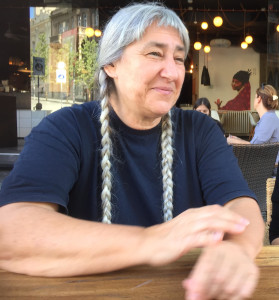
by S. L. Wisenberg
Celebrating Jewish Feminism … in Serbia
About eighty mostly-European, mostly-Jewish feminists gathered in Belgrade, Serbia, in September for the ninth Bet Debora conference. The History of the region makes this significant.
In 1989 the Berlin Wall fell, and the Soviet Union crumbled two years later. There was room for Jewish renewal and flowering in countries that had been behind the Iron Curtain. But not in the former Yugoslavia.
Instead, in the early 1990s when Rosh Hodesh groups were first gathering in a united Berlin, Yugoslavia was turning into a failed and former country. When travelers in Prague were following women-led Jewish tours, Yugoslavia was in civil war. When women throughout the former Soviet bloc were discovering they were Jewish, learning to lead seders, creating egalitarian services and studying for the rabbinate, Jewish women in bombed-out Sarajevo were, alongside men, providing food and medicine to their fellow citizens of all ethnicities.
Ex-Soviet Jews flooded into Germany and Austria at the same time Jews from the former Yugoslavia were fleeing to neighboring countries, the U.S., or making aliyah.
“At some point, the numbers really matter,” said Sonja Viličić, a one-woman Jewish-education dynamo and principal organizer of the conference in Belgrade. In 2018 there were about 6,000 Jews in the seven countries that made up Yugoslavia, according to Berman Jewish DataBank and other sources. There are 1,400 Jews in Serbia, the largest country of the seven. Contrast this to 116,000 in Germany and 47,400 in Hungary.
“This is a Jewish center and a country really trying to have a Jewish life, whatever it means,” Viličić said. About a hundred people gather for High Holiday services in the Serbian capital. “We love our modern Orthodox rabbi,” Viličić said, but the generally secular population doesn’t connect to the religion.


[photos: Sonja Viličić and Ana Lebl on the streets of Belgrade]
One reason Viličić offered to host the traveling conference: “We wanted local people to experience Jewish life that’s not present here,” she told me. On Shabbat at the conference, some locals attended their first egalitarian service, she said, and their first led by a female rabbi. Conference co-organizer Dragana Stojanovic led kiddush in public for the first time, because women aren’t permitted to lead prayers (or read from the Torah) at the Belgrade synagogue.
“It was huge,” Stojanovic said later. “You get this idea that you can do it.”
Both Stojanovic and Viličić grew up in the heterogeneous province of Vojvodina, which is south of Hungary and formerly part of the Austro-Hungarian Empire. Viličić is from Subotica, home of the second-largest synagogue in Europe. She didn’t know she was Jewish, through her father, until she was nine. It was 1990 and her parents took their children to the headquarters of the Jewish community to officially become members. “When the tension started it was often better in the former Yugoslavia to be Jewish because you were out of the conflict,” she explained.
The family started attending services, though only the Holocaust survivors knew the prayers. She was sent to Jewish summer camp Szarvas in Hungary, and returned to Hungary for a decade for college and work in Jewish nonprofits. In Belgrade she founded Haver Serbia, based on Haver Hungary—both educate Jews and non-Jews about Judaism and diversity. She and her mother have since converted to Judaism.
*
Conference presentations ranged from a personal-religious exploration by Anglo-American rabbi Barbara Borts of kol isha, to a report on the life of Serbian writer and historian Ženi Lebl, by her neice Ana Lebl. Ana is president of the Jewish community in Split, Croatia. As a teen, her aunt Ženi was imprisoned for working with the partisans against the Nazis. Despite her patriotic record, she was arrested for repeating a joke about Tito, dictator of Yugoslavia and former leader of the partisans. She was put in prison for two-and-a-half-years, where she was sexually abused. Later she moved to Israel. Other presenters spoke about the relatively high numbers of Jews, including Jewish women, in the Yugoslav partisans.
The Serbian Jewish community is in turmoil, divided over how to spend reparations money. The Ashkenazi cemetery is closed because the descendants are gone. No books have been buried lately in the Sephardic geniza because holy books aren’t being worn out. The community is poor and middle class, said Viličić, and among those in the diaspora there’s not much of a tradition of giving. The country is simply not on the European Jewish map, she said.
And yet. Haver is doing workshops and presentations with other minorities, from the Muslim, differently-abled, LGBT, and Roma communities. On Tu B’Shevat there are discussions about the environment. Conference co-organizer Tanja Kalinic, descendant of the chief rabbi of Serbia, learned Hebrew twenty years ago at the Jewish community center in Belgrade.
“I thought I had no future, economically or professionally, in this country,” Viličić said. “I’m happy I didn’t end up in Israel because I really care about the Jewish community here. The profession I chose and the partner I chose, are rooted here.”